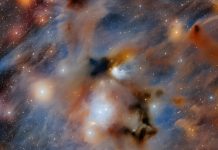
Scientists at the Department of Energy’s Oak Ridge National Laboratory have made a significant breakthrough in understanding nuclear reactions that occur on the surface of neutron stars.
Led by Kelly Chipps, the researchers used a unique gas jet target system to produce a specific nuclear reaction in a lab setting, shedding light on the processes that generate diverse nuclear isotopes in stellar environments.
The study improves our understanding of stellar dynamics and the formation of elements, from people to planets.
Neutron stars are of great interest to nuclear physicists and astrophysicists due to their unique properties.
The immense gravitational pull of a neutron star allows it to capture hydrogen and helium from a neighboring star, which accumulates on its surface and ignites in repeated explosions, resulting in the creation of new chemical elements.
However, many nuclear reactions involved in these explosions remain poorly understood.
The team, known as Jet Experiments in Nuclear Structure and Astrophysics (JENSA), conducted their research using a gas jet target system developed at Oak Ridge National Laboratory.
This system produces the highest-density helium jet in the world for accelerator experiments, allowing researchers to study nuclear reactions that occur both on Earth and in outer space.
Nucleosynthesis, the process of creating new atomic nuclei, occurs when elements undergo transformations by capturing, exchanging, or expelling protons or neutrons.
By striking a target of alpha particles with a beam of argon-34, the scientists produced calcium-38 nuclei, which eventually transformed into potassium-37 nuclei.
The high-resolution detectors surrounding the gas jet provided precise measurements of the energies and angles of the reaction products, allowing the researchers to calculate the dynamics of the reaction.
The results of the experiment directly constrain the theoretical model used to predict element formation and provide valuable insights into the dynamics of stellar processes.
The JENSA system, developed at Oak Ridge National Laboratory and now located at the Facility for Rare Isotope Beams, allows for further experiments to measure the reactions that power exploding stars.
These experiments will contribute to a better understanding of nuclear reactions occurring on the surface of neutron stars.
Neutron stars, which are born from the collapse of massive stars, are incredibly dense objects. Just one teaspoon of neutron star material would weigh as much as a mountain.
They rotate rapidly and possess strong magnetic fields, making them fascinating objects to study.
The extreme conditions found on neutron stars provide a unique opportunity to explore how matter behaves under such extreme gravitational forces.
To unravel the mysteries of neutron stars, a multidisciplinary approach is necessary.
Astronomers observe and collect data, theoreticians develop models to understand the physics inside the stars, and nuclear physicists conduct lab experiments to measure and test reactions against theoretical predictions.
By combining these efforts, scientists gain a deeper understanding of the complex processes occurring on neutron stars.
The recent research conducted by JENSA enhances our understanding of nuclear reactions that take place when material falls onto the surface of neutron stars.
The findings also contribute to our knowledge of nucleosynthesis and element formation in the universe.
The next steps for the researchers involve further testing of the statistical model used and exploring the transition where the model breaks down.
By continuing to investigate nuclear reactions in different atomic mass ranges, scientists can refine their understanding of these processes and improve theoretical models.
This groundbreaking research brings us closer to uncovering the mysteries of neutron stars and the cosmic processes that shape the elements around us.
By studying these stellar phenomena, scientists are not only advancing our knowledge of the universe but also gaining insights into fundamental processes that have implications for life on Earth.
Source: Oak Ridge National Laboratory.



